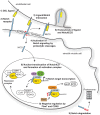Molecular pathways of notch signaling in vascular smooth muscle cells
- PMID: 22509166
- PMCID: PMC3321637
- DOI: 10.3389/fphys.2012.00081
Molecular pathways of notch signaling in vascular smooth muscle cells
Abstract
Notch signaling in the cardiovascular system is important during embryonic development, vascular repair of injury, and vascular pathology in humans. The vascular smooth muscle cell (VSMC) expresses multiple Notch receptors throughout its life cycle, and responds to Notch ligands as a regulatory mechanism of differentiation, recruitment to growing vessels, and maturation. The goal of this review is to provide an overview of the current understanding of the molecular basis for Notch regulation of VSMC phenotype. Further, we will explore Notch interaction with other signaling pathways important in VSMC.
Keywords: Notch; signaling; vascular smooth muscle.
Figures




Similar articles
-
Notch and vascular smooth muscle cell phenotype.Circ Res. 2008 Dec 5;103(12):1370-82. doi: 10.1161/CIRCRESAHA.108.187534. Circ Res. 2008. PMID: 19059839 Review.
-
The miR-143/145 cluster is a novel transcriptional target of Jagged-1/Notch signaling in vascular smooth muscle cells.J Biol Chem. 2011 Aug 12;286(32):28312-21. doi: 10.1074/jbc.M111.221945. Epub 2011 Jun 17. J Biol Chem. 2011. PMID: 21685392 Free PMC article.
-
A novel mechanism of transcriptional repression of p27kip1 through Notch/HRT2 signaling in vascular smooth muscle cells.Thromb Haemost. 2006 Sep;96(3):361-70. doi: 10.1160/TH06-04-0224. Thromb Haemost. 2006. PMID: 16953280
-
Cartilage oligomeric matrix protein is a novel notch ligand driving embryonic stem cell differentiation towards the smooth muscle lineage.J Mol Cell Cardiol. 2018 Aug;121:69-80. doi: 10.1016/j.yjmcc.2018.07.002. Epub 2018 Jul 4. J Mol Cell Cardiol. 2018. PMID: 29981303
-
Notch Signaling in Vascular Smooth Muscle Cells.Adv Pharmacol. 2017;78:351-382. doi: 10.1016/bs.apha.2016.07.002. Epub 2016 Aug 26. Adv Pharmacol. 2017. PMID: 28212801 Free PMC article. Review.
Cited by
-
New Insights into the Pathogenesis of Giant Cell Arteritis: Mechanisms Involved in Maintaining Vascular Inflammation.J Clin Med. 2022 May 20;11(10):2905. doi: 10.3390/jcm11102905. J Clin Med. 2022. PMID: 35629030 Free PMC article. Review.
-
Notch signaling in astrocytes mediates their morphological response to an inflammatory challenge.Cell Death Discov. 2019 Apr 3;5:85. doi: 10.1038/s41420-019-0166-6. eCollection 2019. Cell Death Discov. 2019. PMID: 30962951 Free PMC article.
-
Distinct gene expression profiles associated with Notch ligands Delta-like 4 and Jagged1 in plaque material from peripheral artery disease patients: a pilot study.J Transl Med. 2017 May 4;15(1):98. doi: 10.1186/s12967-017-1199-3. J Transl Med. 2017. PMID: 28472949 Free PMC article.
-
Notch1 promotes ordered revascularization through Semaphorin 3g modulation of downstream vascular patterning signalling factors.J Physiol. 2022 Feb;600(3):509-530. doi: 10.1113/JP282286. Epub 2022 Jan 17. J Physiol. 2022. PMID: 34921404 Free PMC article.
-
SVEP1 is a human coronary artery disease locus that promotes atherosclerosis.Sci Transl Med. 2021 Mar 24;13(586):eabe0357. doi: 10.1126/scitranslmed.abe0357. Sci Transl Med. 2021. PMID: 33762433 Free PMC article.
References
-
- Arboleda-Velasquez J. F., Rampal R., Fung E., Darland D. C., Liu M., Martinez M. C., Donahue C. P., Navarro-Gonzalez M. F., Libby P., D’Amore P. A., Aikawa M., Haltiwanger R. S., Kosik K. S. (2005). CADASIL mutations impair Notch3 glycosylation by Fringe. Hum. Mol. Genet. 14, 1631–163910.1093/hmg/ddi171 - DOI - PubMed
Grants and funding
LinkOut - more resources
Full Text Sources

